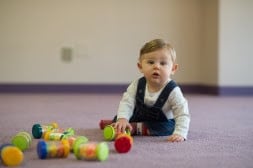Parenting Tip: Explore kitchen sound-makers with baby. Why? The distinctive quality of a sound is called its timbre (pronounced “tam-ber”). In Kindermusik classes, and in everyday life, baby hears a variety of sounds – scratchy sounds, booming drum sounds, individual voices and groups of voices singing and speaking, and many others. As Baby experiences the variety of sounds he can make with musical instruments and everyday objects, he is developing the listening vocabulary necessary for sound discrimination preceding language. And if she plays the instruments, she learns that she can create a nice-sounding result. How? This week go on a scavenger hunt for interesting sound sources at home. Then join Baby in “playing” the instruments you have found. How are they similar to and different from the sounds you hear in Kindermusik class? Try to find: Ribbed plastic water bottles and a wooden spoon; Stainless steel bowl and wooden spoon; Unopened single-serving dried soups: shake and listen; Small paper lunch bags Play with the timbre of your voice while talking with your baby. Use a high voice, low voice, scratchy voice, squeaky voice, and more. Which timbre is the most engaging for your baby? Using Kindermusik (or other) instruments, play with and help your baby compare the sounds of metal jingles to wooden sticks, etc. Listen to the Moon Dance Lullaby this week (from Kindermusik’s Playtime CD). There is a great variety of timbres to discover, both vocal and instrumental in this traditional Chinese lullaby. Do you have a drum at home? Find ways to make a scratching “ritsch, ratsch” sound and then a “boom” sound. Sing the "Little Green Frog" song together (also found on the Playtime CD) while playing the drum. Find a drum for each member of your family and create a drum circle! Try some of these moves for the Jack in the Box song – and delight in the goofy sound effects, with baby! Want to Learn More? On our blog: The connection between timbre and phonemic awareness. Kindermusik 7-Year Continuum: Helping baby to experience multiple timbres (sounds) now, will help her have familiarity with those sounds when she chooses an instrument to explore in toddler classes. As a preschooler, he’ll have the sound vocabulary to be able to choose appropriate instruments to accompany poems, stories, and songs in Kindermusik. As a big kid in Young Child classes, your child will use that knowledge of sounds to choose instruments for group compositions, and to know if their instrument is playing in tempo with the group.
Warning: Illegal string offset 'url' in /hermes/bosnacweb04/bosnacweb04ci/b737/dot.kathysmusic/public_html/site/wp-content/themes/babykids/single.php on line 13



Leave a Reply